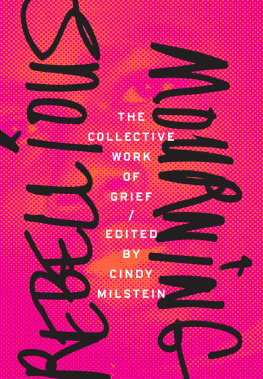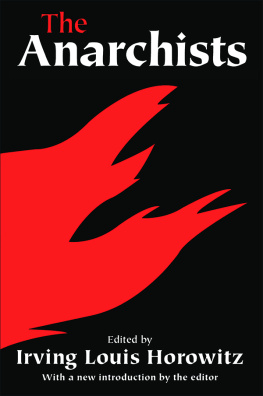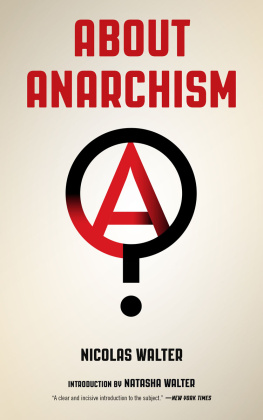Table of Contents
Praise for Anarchism and Its Aspirations
One of the strongest speakers and writers in North
American radical movements and anarchist networks, its
about damn time that Cindy Milsteins amazing thinking and
writing is put together in a book. Simultaneously a participant
in popular radical movement actions and articulating the
theory behind the actions, she paints a clear-headed vision of
the free and just world were fighting for. Uncompromising,
practical, and hopeful, this book is essential reading for all who
are taking on climate change, war, or corporate capitalism, and
know that a better world is both possible and necessary!
David Solnit, coauthor of The Battle of the Story of the Battle of Seattle
Ive often been asked by people for a book on anarchism
that gives them an idea, and Ive often wondered what I
could recommend that is all at once concise, profound, highly
readable, and up to date. Cindy Milstein has now solved this
problem. In these wonderful essays, she brings together anar
chist history and current developments with ease, illustrating
how the core values, ideas, and principles of anarchism remain
the same while their expressions change according to times,
places, and circumstances. You will find it hard to put down
this book until youre finished, and it will leave you longing
for more intelligent and inspiring thoughts on how to make
this world a better place for all of us. I expect Anarchism and
Its Aspirations to become the introduction to anarchism of the
next decadeand I certainly hope it will be!
Gabriel Kuhn, editor of Gustav Landauers Revolution and Other Writings
Milsteins work is a clear and passionate account of the anarchism that lives beyond any particular organization, as an expression of humanitys indestructible desire for a world free from hierarchies and all forms of domination. The book is also a road map to the many social and cultural movements that anarchism has traversed, from the Provos to radical ecology and Zapatismo, and a testimony to its continuing ability to capture the radical imagination. Above all, the book is a call to live the revolution now, making of our daily lives a prefiguration of the egalitarian and cooperative ethics that anarchism aspires to.
Silvia Federici, author of Caliban and the Witch
In a crazy world full of complexity, contradiction, and irony, its easy to lose your footing. If you are looking for a solid place to root your analysis, this is a fabulous place to land. Cindy Milsteins book is thoughtful, energetic, and visionary, and will give you a ton to chew on. It is a brilliant primer of anarchist politics.
Matt Hern, author of Common Ground in a Liquid City
At a time when anarchism is no longer merely the most revolutionary political theory and praxis but also the only one left, it is even more important to rescue it from the dangers of potential fossilization. A century ago, another danger- ous woman, Emma Goldman, reminded us that anarchism should not be a theory of the future but rather a living force in the affairs of our life, constantly creating new conditions. Goldmans voice resonates strongly in this beautiful and inspirational book, which offers the much-needed hope that every individualhere and nowcan change this world and create it anew.
iga Vodovnik, author of Anarchy of Everyday Life
Anarchist Interventions: An IAS/AK Press Book series
Radical ideas can open up spaces for radical actions, by illuminating hierarchical power relations and drawing out possibilities for liberatory social transformations. The Anarchist Intervention seriesa collaborative project between the Institute for Anarchist Studies (IAS) and AK Pressstrives to contribute to the development of relevant, vital anarchist theory and analysis by intervening in contemporary discussions. Works in this series will look at twenty-first-century social conditionsincluding social structures and oppression, their historical trajectories, and new forms of domination, to name a fewas well as reveal opportunities for different tomorrows premised on horizontal, egalitarian forms of self-organization.
Given that anarchism has become the dominant tendency within revolutionary milieus and movements today, it is crucial that anarchists explore current phenomena, strategies, and visions in a much more rigorous, serious manner. Each title in this series, then, will feature a present-day anarchist voice, with the aim, over time, of publishing a variety of perspectives. The series multifaceted goals are to cultivate anarchist thought so as to better inform anarchist practice, encourage a culture of public intellectuals and constructive debate within anarchism, introduce new generations to anarchism, and offer insights into todays world and potentialities for a freer society.
Prologue
Anarchism and Its Aspirations doubles as a book and a bookend. I finished the manuscript on the tenth anniversary of the battle of SeattleNovember 30, 2009. A decade ago, that same mass mobilization and the anarchism that it made visible in North America spurred me to write for the new anticapitalist movement of movements as part of my political work. Chapter 3, Democracy Is Direct, was the first result of that effort. It was penned for the booklet Bringing Democracy Home, which an anarchist group of us produced and then distributed for free, by the thousands, on the streets of Washington, DC, at the A16 direct action against the International Monetary Fund and World Bank meetings in spring 2000.
As a book, I hope this small collection of essays contributes to building a better anarchism and encouraging new anarchists. I hope it sparks debate about what anarchism is and could be, first and foremost because I want us to be effectiveto winand that involves critical yet constructive dialogue as integral to our prefigurative practice. And I hope that the ideals expressed here stand the test of time, because I firmly believe in the expansive ethical sensibility that has marked anarchism as a tradition. Like many anarchists, I know that words can indeed be weapons. Thats why I write. It is my greatest hope, then, that this book adds to our arsenal as we fight to institute a nonhierarchical society.
As a bookend, though, I worry that the lavish emphases of ten years agodirect democracy, unity in our diversity, and a cooperative, creative impulse, among othershave been lost. Such loss can certainly be attributed to the numerous historical events over the past decade that seem to have gone from bad to worse, crushingly so: 9/11, wars on terror, green and brown scares, Katrina and now Haiti, accelerating ecological and economic devastation. Sadly the list could go on. But I worry that in the face of this morass, anarchists are becoming increasingly nihilistic and far less concerned about ending social suffering. The ever-crueler, more alienating world appears to be doing far more damage to us than we have the capacity, much less stamina, to do to it. It troubles me that as I finish this book, I get the eerie sensation that I might have to shelve my own aspirations for what anarchists can accomplish, just when we are needed more than ever.
This may be my own sorrow speaking, from the standpoint of a bookended period that began with so much potential, so much exuberance, and seems to have ended in such despair. The gap between the ideals advanced by anarchism and the actual social reality today, even within anarchist circles, can be greatdispiritingly so, if one is a self-reflective anarchist. Contemporary anarchism can appear messy. In practice, it manifests all the forms of hierarchy, domination, and oppression that one finds elsewhere. Its subcultural codes of dress, say, or its sometimes-tired protest tactics can make it seem like a parody of itself. Chapter 4, Reclaim the Cities: From Protest to Popular Power, written midway through this bookended time and revised for this book, was one attempt to address this problem. For newcomers, the gateway to the lived world of anarchism can be rusty and unwelcoming , and many of you will exit all too quickly. As one friend morosely joked recently, the past decade has seen three generations of anarchists come and go.











